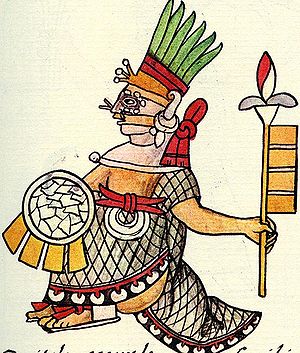
In Aztec religion, Painal (also spelled Paynal or Painalton, "Little Painal"; also spelled Paynalton; Classical Nahuatl: Payīnal [paˈjiːnaɬ], Payīnaltōn, Payīnaltzin) was sometimes interpreted by Spanish colonists as a god (teotl) who served as a representative of Huitzilopochtli.[1][2] Other scholars have noted that Paynala may have been a toponym, confused for a person.[2]
Bernardo de Sahagún's General History of the Things of New Spain, commonly called the Florentine Codex, briefly describes Painal thus:
Paynal was "the delegate," "the substitute," "the deputy," because he represented Uitzilopchtli. When there was a procession he was given the name Paynal, because they pressed him on quickly; he was made to hasten.
References
[edit]- ^ Roith, Christian (2018). "Representations of hands in the Florentine Codex by Bernardino de Sahagún (ca 1499–1590)". Paedagogica Historica. 54 (1–2): 114–133. doi:10.1080/00309230.2017.1360918. S2CID 148929704.
- ^ a b Miller, Mary E. (2005). "Rethinking Jaina: Goddesses, Skirts, and the Jolly Roger". Record of the Art Museum, Princeton University. 64: 67. JSTOR 3774835.
Well, that’s interesting to know that Psilotum nudum are known as whisk ferns. Psilotum nudum is the commoner species of the two. While the P. flaccidum is a rare species and is found in the tropical islands. Both the species are usually epiphytic in habit and grow upon tree ferns. These species may also be terrestrial and grow in humus or in the crevices of the rocks.
View the detailed Guide of Psilotum nudum: Detailed Study Of Psilotum Nudum (Whisk Fern), Classification, Anatomy, Reproduction